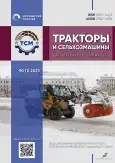Метод выявления потери устойчивости движения тракторов при реализации тягового усилия на прицеп или сцепной агрегат
- Авторы: Жилейкин М.М.1, Сиротин П.В.2, Носиков С.С.2, Пуляев Н.Н.3
-
Учреждения:
- Инновационный центр «КАМАЗ», Инновационный центр Сколково
- Южно-Российский государственный политехнический университет имени М.И. Платова
- Российский государственный аграрный университет – МСХА им. К.А. Тимирязева
- Выпуск: Том 90, № 1 (2023)
- Страницы: 39-48
- Раздел: Теория, конструирование, испытания
- URL: https://bakhtiniada.ru/0321-4443/article/view/132485
- DOI: https://doi.org/10.17816/0321-4443-321266
- ID: 132485
Цитировать
Аннотация
Обоснование. В настоящее время комбайны и тракторы, являясь наиболее энергоемкими транспортно-технологическими комплексами сельскохозяйственного назначения, во многом определяют возможность перехода к ведению эффективного и экологически чистого агрохозяйства, а также обеспечивают технический аспект преобразования агропромышленного комплекса в передовой сектор промышленности страны. Одним из источников возникновения динамических нагрузок в узлах и агрегатах тракторной техники являются автоколебательные режимы.
Цель работы — изучение условий возникновения автоколебательных процессов в конструкции тракторных поездов на колесном ходу и разработка методов повышения устойчивости, управляемости и безопасности их движения за счет снижения галопирования и рыскания трактора-тягача при буксировке тяжелых грузов.
Материалы и методы. Установлено, что ввиду связанности колебаний по продольным перемещениям трактора-тягача и тележки-прицепа с колебаниями по вертикальным перемещениям центра масс и по углу продольно-угловых колебаний трактора-тягача при возникновении автоколебательного режима в зоне взаимодействия эластичного колеса с твердым опорным основанием тот же режим автоколебаний возникнет и по указанным степеням свободы. Причем можно указать последовательность возникновения автоколебательных режимов в различных зонах конструкции тракторного поезда.
Результаты. Сначала автоколебания возбуждаются в зоне контакта колеса с опорным основанием при возникновении полного скольжения, потом начинаются автоколебания по продольному углу наклона корпуса трактора-тягача и после этого начинаются автоколебания по вертикальным перемещениям центра масс трактора-тягача. Колебания по углу складывания тракторного поезда связаны с колебаниями по поступательному движению центров колес, что приводит к возникновению автоколебательного режима, как при частичном, так и при полном скольжении в зоне взаимодействия эластичной шины с твердым опорным основанием. Поскольку автоколебания на каждом из колес возникают в случайные моменты времени, то автоколебания трактора-тягача по углу складывания будут носить хаотичный характер.
Заключение. Практическая ценность исследования заключается в возможности использования предложенных методов выявления опасности возникновения автоколебательных процессов при проектировании перспективных видов сельскохозяйственной техники.
Полный текст
Открыть статью на сайте журналаОб авторах
Михаил Михайлович Жилейкин
Инновационный центр «КАМАЗ», Инновационный центр Сколково
Автор, ответственный за переписку.
Email: jileykin_m@mail.ru
ORCID iD: 0000-0002-8851-959X
SPIN-код: 6561-3300
д-р техн. наук, руководитель группы инженерных расчетов
Россия, МоскваПавел Владимирович Сиротин
Южно-Российский государственный политехнический университет имени М.И. Платова
Email: spv_61@mail.ru
ORCID iD: 0000-0002-7066-5062
SPIN-код: 2801-3166
доцент, канд. техн. наук, заведующий кафедрой «Автомобили и транспортно-технологические комплексы»
Россия, НовочеркасскСергей Сергеевич Носиков
Южно-Российский государственный политехнический университет имени М.И. Платова
Email: nosikov1997@mail.ru
ORCID iD: 0000-0002-9011-5017
SPIN-код: 5155-8609
ассистент кафедры «Автомобили и транспортно-технологические комплексы»
Россия, НовочеркасскНиколай Николаевич Пуляев
Российский государственный аграрный университет – МСХА им. К.А. Тимирязева
Email: pullman-mpt@mail.ru
ORCID iD: 0000-0001-8984-4426
SPIN-код: 1436-9093
доцент, канд. техн. наук, доцент кафедры «Тракторы и автомобили»
Россия, МоскваСписок литературы
- Бабкин К.А. Разумная промышленная политика или как нам выйти из кризиса. М.: Манн, Иванов, Фербер, 2009.
- Субаева А.К. Сельскохозяйственная техника России в ВТО // Экономические исследования. 2013. № 1. С. 14-28.
- Распоряжение Правительства РФ от 07.07.2017 N 1455-р «Об утверждении Стратегии развития сельскохозяйственного машиностроения России на период до 2030 года». Режим доступа: http://government.ru/docs/28393/
- Бурак П.И., Пронин В.М., Прокопенко В.А. и др. Сравнительные испытания сельскохозяйственной техники: науч. издание. М.: ФГБНУ Росинформагротех, 2013.
- Вестник испытаний сельскохозяйственной техники (2018). Кинель: АИСТ, 2018. Дата обращения: 05.10.2022. Режим доступа: https://rosinformagrotech.ru/data/elektronnye-kopii-izdanij/rastenievodstvo/send/5-rastenievodstvo/114-vestnik-ispytanij-selskokhozyajstvennoj-tekhniki-2018
- Вестник испытаний сельскохозяйственной техники (2017). Кинель: АИСТ, 2017. Дата обращения: 05.10.2022. Режим доступа: https://rosinformagrotech.ru/data/send/5-rastenievodstvo/606-vestnik-ispytanij-selskokhozyajstvennoj-tekhniki-2017
- Кравченко В.А., Меликов И.М. Оценка агротехнических свойств движителей зерноуборочных комбайнов с шинами различного конструктивного исполнения // Аграрный научный журнал. 2020. № 5. С. 93-98. doi: 10.28983/asj.y2020i5pp93-98
- Русанов В.А. Проблема переуплотнения почв движителями и эффективные пути ее решения: монография. Москва: ВИМ, 1998.
- Сиротин П.В., Лебединский И.Ю., Кравченко В.В. Анализ виброакустической нагруженности рабочего места операторов зерноуборочных комбайнов // Современные наукоемкие технологии. Региональное приложение. 2018. №1(53). С. 113–121.
- Kotiev G.O., Padalkin B.V., Kartashov A.B., et al. Designs and development of Russian scientific schools in the field of cross-country ground vehicles building // ARPN Journal of Engineering and Applied Sciences. 2017. Vol. 12, N 4. P. 1064-1071.
- Эргин А.А., Коломейцева М.Б., Котиев Г.О. Антиблокировочная система управления тормозным приводом автомобильного колеса // Приборы и системы управления. 2004. № 9. С. 11–13.
- Soliman A.M.A., Kaldas M.M.S. An Investigation of Anti-lock Braking System for Automobiles // SAE 2012 World Congress & Exhibition. SAE International by Warwick University, 2016. doi: 10.4271/2012-01-0209
- Sun C., Pei X. Development of ABS ECU with Hardware-in-the-Loop Simulation Based on Labcar System // SAE Int. J. Passeng. Cars – Electron. Electr. Syst. 2015. Vol. 8, N 1. P. 14–21. doi: 10.4271/2014-01-2524
- Sabbioni E., Cheli F., D’Alessandro V. Analysis of ABS/ESP Control Logics Using a HIL Test Bench // SAE 2012 World Congress & Exhibition. SAE International by Warwick University, 2011. doi: 10.4271/2011-01-0032
- Hart P.M. Review of Heavy Vehicle Braking Systems Requirements (PBS Requirements), Draft Report. № 01599066. ARRB, 2003.
- Marshek K.M., Guderman II J.F., Jonson M.J. Performance of Anti-Lock Braking System Equipped Passenger Vehicles Part I: Braking as a Function of Brake Pedal Application Force // SAE 2002 World Congress Detroit, Michigan March 4-7, 2002. SAE International by Warwick University, 2002. doi: 10.4271/2002-01-0304
- Решмин С.А. Качественный анализ нежелательного эффекта потери силы тяги транспортного средства во время интенсивного старта // Доклады академии наук. 2019. Т. 484, № 3. С. 289–293. doi: 10.31857/S0869-56524843289-293
- Кузнецов А.П., Кузнецов С.П., Рыскин Н.М. Нелинейные колебания. М.: Физматлит, 2002.
- Жилейкин М.М. Исследование автоколебательных процессов в зоне взаимодействия эластичной шины с твердым опорным основанием // Известия высших учебных заведений. Машиностроение. 2021. № 10. C. 3–15. doi: 10.18698/0536-1044-2021-10-3-15
Дополнительные файлы









